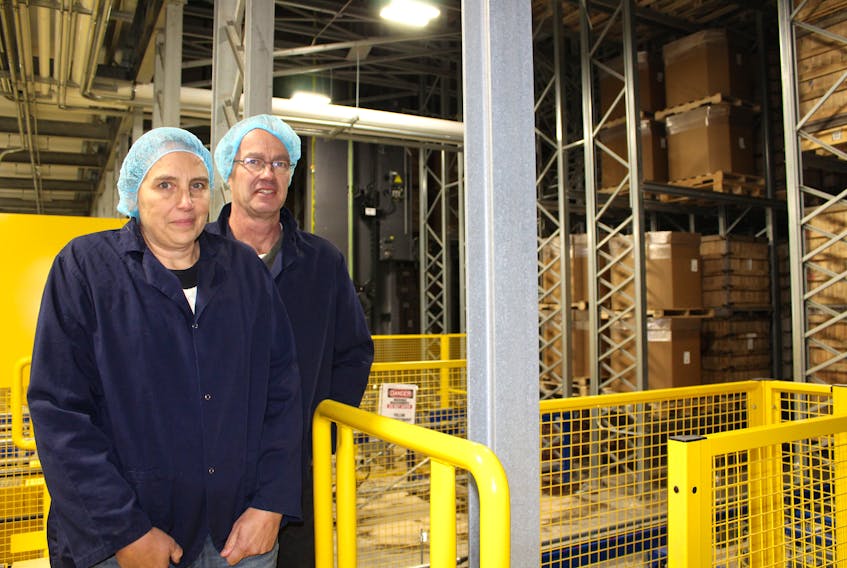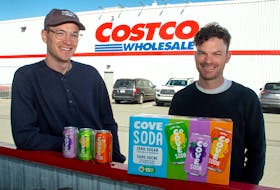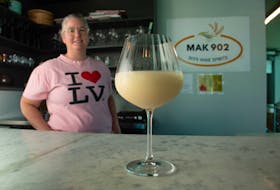SACKVILLE, N.B. — BY MARILYN LERCH
When Evelyn and David Ernst graduated from Mount Allison University in 1990, little did they know or expect that in a few years they would become the largest exporters of cranberries in Atlantic Canada.

Likewise, Sackville would not have known that its industrial park would become the site of a ghost-like structure, visible for miles from every direction, standing 44 meters tall on the edge of the Tantramar marsh, containing space for 20 million pounds of frozen berries.
Hmm, seems to be a story or two here . . .
Evelyn and David, both Lunenburg County, Nova Scotia, natives, married in 1991 and began the family that grew into two sons and two daughters. David with an applied engineering degree from Queens University worked at High Liner Foods in Lunenburg and Evelyn taught music at an area high school. When the fishing industry began to dry up and twelve boggy acres came up for sale in 1998, their lives took a major turn in a quite unexpected direction.

“David built the cranberry farm on Heckman’s Island from scratch,” explained Evelyn. “We saw him at breakfast, but after a day’s work at High Liner and a quick supper, off he went to play with his excavator, clearing land, creating flat beds and an irrigation system.”
David credits the generous advice and help from other local cranberry farmers as well as a course in cranberry farming provided by the provincial Department of Agriculture for giving him a good start.
Evelyn laughs remembering the first year or so after cranberry harvests began.
“Yes, we rolled cranberries down an inclined window screen to clean and sort them, bought a couple of freezers, and started kitchen canning. I hauled fresh-off-the-field cranberries to local markets and we eventually opened a u-pick, which was the first cranberry u-pick in Nova Scotia.”
Their children grew up working on the farm. At age five, eldest son John was able to drive an excavator to load a dump truck and who, by the way, will join the business after graduating from the commerce program at Queen’s University next spring.
What began as a family operation turned into Terra Beata Cranberry Farm, which today receives cranberries from about a dozen Atlantic Canada farms, including many in New Brunswick. The home-kitchen canning evolved to a commercial location in 2005 producing award-winning dried fruit, gourmet preserves and juices.
“People came to us hoping for dried cranberries that had less sugar,” said Evelyn. “So we began experimenting and now we have market dried cranberries that retain their vitamins and have forty percent less sugar than many commercial brands. When enough people bring us the same questions, we will figure out how to answer them.”
And that pretty well sums up my impressions of this 51-year old couple, a can-do attitude, tremendous energy and hard, hard work. From using a window screen to wash the harvest to exporting cranberries to Australia, Europe, China and across Canada and operating a 20-million pound capacity freezing plant in Sackville, none of this fazes David.
“Being close to Halifax gives us some leverage in getting our cranberries shipped internationally, and the south shore is warmer than many places where cranberries are grown, so we harvest later.”

And that brought me to the question of why Sackville?
I didn’t get any sentimental stories about how much they love Mount Allison, although Evelyn says that a course in bio-chemistry given by former professor Jack Stewart did influence her interest in food safety and processing.
It was geography of course.
“Look,” said David, “Sackville is central between PEI, New Brunswick and Nova Scotia. It is a few seconds off the Transcan, there are no traffic jams and snowplows sit right across the street.”
And, added Evelyn, “We both do love small towns.”
There are 25 full-time employees at the food processing plant, mainly from the Sackville area. David relates the story of one gentleman who came time after time as the freezer plant was being built, insisting that he wanted a real job. And as soon as hiring started, he was taken on.
“I believe the employees are proud to be part of an operation that is well run, and we are proud of them. Our goals were to provide good employment and help other area businesses.”
Mike Nodding, operations manager, with 34 years of food processing experience, jumped at the chance to start the Sackville plant from scratch.
It is obvious that the Ernsts are proud of the “cube” as locals call the freezing plant. Two million pounds of steel went into the frame. Eight million pounds of concrete and rebar form the foundation. What a relief to know a Fundy gale will not blow the structure down.
The refrigeration system is cutting edge. It uses CO2, not ammonia, as the refrigerant. Less energy is used to do the same work as ammonia. And, in the unlikely event of a leak, CO2 is far safer than ammonia. If the power goes out, due to its large thermal mass, the freezer will stay cold for at least a week, even in the summer.
Importantly, this is the second structure in all of Canada to be built with a fire prevention system, where the atmosphere is controlled to increase nitrogen and lower oxygen just to the point that you cannot light a match inside the gigantic freezer.
Presently five million pounds of berries are stored in the twenty-million pound capacity freezer. The rest of the space will be rented to other companies. This is an example of how the Ernsts can help area businesses because there has been a lack of such storage capacity.
And then, as I hoped would happen, I stepped into high rubber boots, put on a jacket and green hairnet, washed my hands thoroughly and was given a guided tour by Evelyn. We entered the huge food processing plant which was built by Burnbrae Farms in 2007. Evelyn said that partnering with this major Canadian egg producer to use their existing building made possible the building of the freezing unit.
I was surprised to learn that not only cranberries are processed here. Rhubarb comes in June, Haskap berries in July, blueberries in August and September, and cranberries in October and November.
The processes for all these fruits are basically the same: fresh fruit arrives by the truckload. As it is conveyed into the building, leaves, sticks, soft rotten fruit and tiny un-ripened fruit are removed by a succession of blowers, shakers, brushes and float tanks. The good fruit is washed, dried by a vacuum, and flowed in a single layer on a wide conveyor belt into a tunnel freezer. After a five-minute journey, the fruit emerges individually quick frozen and falls into bulk totes, each holding about 1,000 pounds. This receiving line can handle over 200,000 pounds of cranberries in a single shift. During blueberry season, it runs 24 hours a day, 7 days a week.
People unload the trucks, ensure the machinery is running correctly, use hoses and fresh water to clean the floor and the equipment constantly, assemble bins, weigh deliveries and finished product, drive forklifts, prepare grading reports, take quality samples and track paperwork. No jobs are particularly dangerous and everyone receives training.
Each crate holding one thousand pounds of berries is, as it were, filed at a computer station. Once through the blue door, it is placed on one of four tracks, lifted by one of four cranes and placed in storage. Every crate can be located if need be. The freezing plant is fully automated.
Oh, yes, I did step into the freezer. My first taste of winter at -20 degrees Celsius!
Throughout the year, the bulk totes are removed from storage and the fruit goes to the re-pack line, where it is carefully examined by an optical colour sorter and double checked by employees to remove any remaining leaves or poor quality berries. Some of this fruit travels to Terra Beata’s original facility in Lunenburg, N.S., where it is made into cranberry sauce, juices, and dried fruit sold through Canadian grocery stores. The rest is destined for export around the world – about two containers a week will leave through the Port of Halifax and travel to customers in Europe, Australia, Israel, and China.
The Ernsts insist they have no formal training.
“We have picked up bits and pieces from other farmers, other processors, other exporters,” says Evelyn. “People have been generous and helpful sharing their experience, stories and knowledge – and David loves to talk and he is a natural problem solver, driven by a desire to always make things better.”
So what next? As I leave the plant, Evelyn comments, “I will not spill any beans, but I am sure the next few decades will not be dull.”
I’m convinced!
RELATED:
Massive freezer facility going up in Sackville industrial park
Dorchester’s Coastal Cranberries finally finishes fall cranberry harvest








